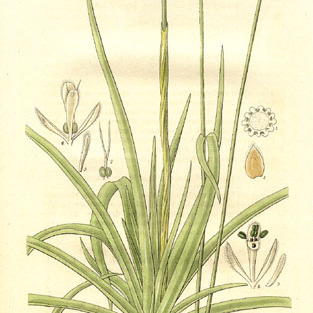Stems mostly very short, rarely elongate and equally covered with leaves throughout; leaves mostly tufted, membranous or very thin and pellucid, more or less linear or linear-lanceolate and grass-like, sessile and clasping at the base, very often fenestrate; florets dimerous or trimerous, the staminate mixed with the pistillate or segregated on separate heads or (rarely) on separate plants; perigonium almost always double; staminate florets with the sepals free at the base or often more or less connate into a split spathe, the 2 or 3 petals united below into a tube, free at the apex, the lobes usually bearing a small black gland on the inner surface near the apex; stamens twice as many as the sepals (or rarely 3) and exserted; anthers 4-celled, mostly black, composed of 2 thecae; pistillate florets with free or (rarely) spathaceous-connate sepals; petals free or rarely none, usually each bear-ing a small black gland slightly below the apex within; style-appendages none; stigmas 2 or 3, simple.
Herbs scapigerous, aquatic or growing in marshes, rarely on dry ground. Stems very short and disciform, rarely elongate. Leaves radical, linear. Scapes 3--8-ribbed; sheath oblique at mouth. Bracts scalelike. Flowers unisexual, with both sexes in same head, minute. Male flowers: sepals 2 or 3, usually connate into an abaxially split tube, rarely free; petals basally connate and funnelform, large, margin usually ciliate, apex distinctly or indistinctly 2-or 3-lobed, usually bearing a gland; stamens in 2 whorls, adnate to petals; anthers black or rarely yellowish. Female flowers: sepals 2 or 3, free, basally connate, or connate into an adaxial spathe, flat, boatlike, or crested, equal or unequal; petals absent to 3, linear, oblanceolate, or spatulate, margin ciliate, apex often bearing a large gland; ovary 1--3-loculed; style 1--3-branched. Seeds yellowish or brown, 1 per valve; testa usually hexagonally reticulate, prickles small and in rows or absent; embryo minute.
Scapes single, often twisted, enclosed at the base by a tubular sheath. Involucral bracts of the capitulum scarious to coriaceous, spreading or reflexed at maturity; floral bracts frequently white-hairy towards the tip. Flowers sessile or pedicellate on the central receptacle, male and female mixed or the female around the periphery (especially in annuals). Sepals free or ± connate especially in the male flowers, usually free in the female, often navicular, sometimes winged. Petals with a subapical or apical black gland on the inner face, or the glands sometimes reduced or absent, often white-hairy at the tip; male petals all very small or one enlarged and exserted from the capitulum. Stamens twice as many as the petals (except E. angustibracteum ); anthers black or white. Seeds relatively large, ellipsoid, yellow to reddish brown, smooth or distinctively patterned.
Herbs, annual or rarely perennial. Leaves in a basal rosette and typically broadest at base, tapering to an acute to acuminate apex, or rarely cauline and filiform, often with fenestrate thickenings, blade mostly glabrous, often with tangled hyaline hairs in axils. Peduncle erect, rarely poorly developed or lacking, often ribbed, sometimes twisted, glabrous. Petals in male flowers obscure, arising at summit of androphore, black nectariferous gland epipetalous at apex, sometimes obscure. Sepals in female flowers free. Style appendages absent. Seeds ellipsoid, shiny, variously hairy or sculptured, epidermal cells often outlined with wall thickenings and mostly arranged in longitudinal rows.
Fls each subtended by a small bract, dimerous in our spp., the sep 2, distinct or connate, the pet 2, each with a nectariferous gland just within the tip, the ovary bilocular and the style bifid; staminate fls with an androphore; stamens bicyclic (4 in our spp.), exsert at anthesis; anthers with 2 pollen-sacs, black at maturity in our spp.; ovary on a gynophore which also bears the pet; lvs with evident lacunar tissue especially toward the base; roots fleshy-fibrous, septate, pale, unbranched. 400, mainly warm reg. The hairs of the receptacle, mentioned in the key below, are very slender and much elongate, in contrast to the thick short hairs of the perianth and receptacular bracts.

